.jpg)
Mahavir Jayanti, one of the most significant festivals in Jainism, will be observed with great reverence on Tuesday, March 31, 2026 . This auspicious occasion marks the birth anniversary of Bhagwan Mahavira, the twenty-fourth and last Tirthankara of Jainism, who preached the path of non-violence, truth, and renunciation. Celebrated with devotion and grandeur, Mahavir Jayanti is a time for spiritual reflection, temple visits, and acts of charity.
Festival Date, Time, Muhurat & Tithi
Key Timings for Mahavir Jayanti 2026:
2624 th Birth Anniversary of Mahavir Swami
Mahavir Jayanti on Tuesday, March 31, 2026
Trayodashi Tithi Begins - 07:09 AM on Mar 30, 2026
Trayodashi Tithi Ends - 06:55 AM on Mar 31, 2026
Note: Sunrise and sunset vary by region and date due to India's geographical diversity. For exact timings, refer to local astronomical data.
Significance & Importance of Mahavir Jayanti
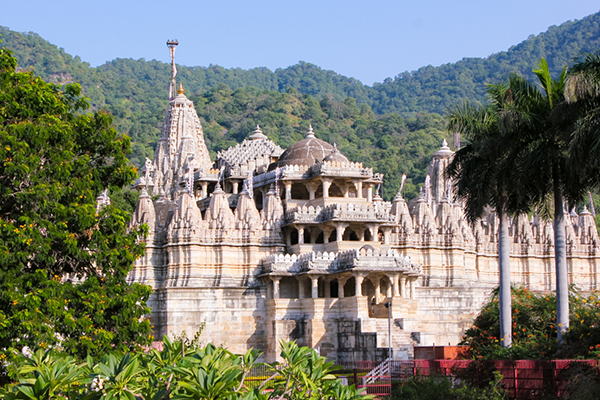
Every year, Mahavir Jayanti serves as a sacred reminder of Bhagwan Mahavira’s profound teachings and his efforts to simplify Jain philosophy, making it accessible to all. On this day, members of the Jain community come together to offer prayers, meditate, and engage in religious discourses. Devotees visit Jain temples, where special pujas and abhishekas (ritualistic bathing of the idol) are performed in honor of the Tirthankara.
The festival is also marked by processions (rath yatras) in various cities, where beautifully decorated chariots carry Bhagwan Mahavira’s idol, accompanied by devotees singing hymns and reciting his teachings. Charity and donations play a significant role in the observance, as followers distribute food, clothing, and essential supplies to the underprivileged, in alignment with Mahavira’s principle of selfless service.
Teachings of Bhagwan Mahavira
Bhagwan Mahavira's philosophy was not confined to India but spread across the world, influencing countless individuals. His teachings emphasized the five main vows (Mahavratas):
- Ahimsa (Non-violence): Complete abstinence from harming any living being in thought, word, or action.
- Satya (Truth): Always speaking and upholding the truth.
- Asteya (Non-stealing): Not taking anything that does not belong to oneself.
- Brahmacharya (Celibacy): Practicing self-discipline and purity.
- Aparigraha (Non-possessiveness): Detachment from material possessions and desires.
Through these principles, Bhagwan Mahavira transformed Jainism into a simple, ritual-free, and accessible spiritual path. His message of compassion, self-discipline, and inner purification remains relevant even today, inspiring millions worldwide.
Impact and Legacy
The teachings of Bhagwan Mahavira have had an everlasting impact on his disciples and continue to resonate across generations. His emphasis on universal peace, environmental harmony, and ethical living has influenced not only Jain philosophy but also modern movements advocating non-violence and sustainability.
On Mahavir Jayanti 2026, let us reflect on his timeless wisdom and strive to embody his principles of kindness, simplicity, and selflessness in our daily lives. This festival is a reaffirmation of his teachings that continue to guide humanity toward a path of righteousness and liberation.
History of Mahavir Jayanti
India, a land of profound spiritual diversity, celebrates numerous festivals, each rooted in history, culture, and religious significance. Among them, Mahavir Jayanti holds immense reverence, particularly for the Jain community, as it marks the birth anniversary of Bhagwan Mahavira, the twenty-fourth and last Tirthankara of Jainism. Celebrated with deep devotion and grandeur, this festival is not merely a day of celebration but a reaffirmation of Mahavira’s timeless teachings that emphasize non-violence (Ahimsa), truth (Satya), compassion, and self-discipline.
Historical Background of Mahavir Jayanti

Bhagwan Mahavira was born in 599 BCE in Kundagrama, a small town near present-day Vaishali in Bihar, India. He was born into a royal family to King Siddhartha and Queen Trishala, who belonged to the Ikshvaku dynasty. According to Jain scriptures, before his birth, Queen Trishala experienced sixteen auspicious dreams, which indicated that her child would be a divine being destined to lead humanity toward spiritual enlightenment. Jain traditions believe that his birth marked a new era of ethical and moral awakening.
Mahavira, originally named Vardhamana, grew up in luxury but renounced his princely life at the age of thirty in pursuit of spiritual liberation. For twelve years, he engaged in intense meditation, severe austerities, and deep contemplation, enduring hardships and remaining steadfast in his spiritual quest. Although people threw sticks, fruits, and stones at him to disrupt his meditation, Mahavira remained unaffected, braving the harsh winters and scorching summers.
Ultimately, in the thirteenth year of his spiritual journey, Mahavira attained Kevala Jnana (supreme knowledge or omniscience), becoming a fully enlightened Tirthankara. After achieving enlightenment, he traveled extensively, visiting places like Sravasti, Mithila, Vaishali, Champa, and Rajagriha, where he preached his teachings to both kings and commoners. Influential rulers such as King Bimbisara and King Ajatasatru offered their respects and held him in great veneration. He continued to spread his philosophy until he attained nirvana (liberation) at the age of seventy-two in Pava, near Rajgir.
The Origin and Evolution of Jainism
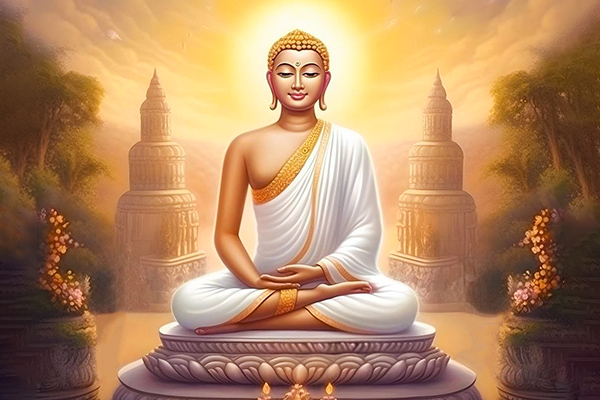
Jainism is an ancient religion that advocates a pathway to liberation and enlightenment through compassion and non-violence towards all living beings. The word “Jain” or “Jaina” means “Conqueror”, referring to those who conquer worldly desires and attain spiritual purity. Jainism came into the limelight in the sixth century BCE, primarily due to Bhagwan Mahavira’s efforts in propagating its principles.
There were twenty-four Tirthankaras (spiritual teachers) who guided people toward spiritual emancipation. Mahavira, the last and most prominent Tirthankara, was more of a reformer than a founder, shaping Jainism into its present form. His teachings emphasized simplicity and rationality, stripping away unnecessary rituals and making spirituality accessible to all.
As per the Swetambara Jain community, Mahavira’s mother had fourteen prophetic dreams, leading astrologers to predict that her son would either become a great king or a Tirthankara. True to the prophecy, Mahavira renounced worldly pleasures and attained moksha (liberation) after years of spiritual discipline.
Mahavira played a crucial role in shaping Jainism, making it a practical and philosophical way of life rather than a complex set of rituals. His teachings were not confined to India but resonated globally, influencing spiritual movements emphasizing peace, non-violence, and ethical living.
The Celebration of Mahavir Jayanti
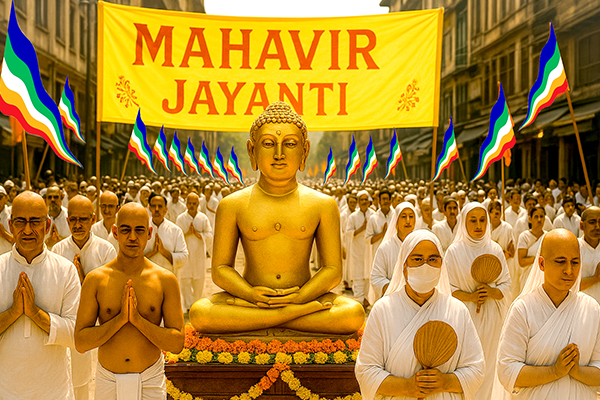
Temple Visits and Ritualistic Worship
On Mahavir Jayanti, devotees visit Jain temples early in the morning to participate in special pujas and abhisheka (ceremonial bathing of Mahavira’s idol). Temples are beautifully decorated with fresh flowers, sacred Jain symbols, and toranas. Devotees offer milk, rice, sandalwood, and fruits while reciting Jain prayers and mantras. Many temples organize spiritual discourses (pravachans), where Jain monks and scholars narrate Mahavira’s life story and preach his core values.
Processions, Charity, and Acts of Compassion
One of the key highlights of Mahavir Jayanti is the Shobha Yatra (grand procession), where Mahavira’s idol is carried on an ornate chariot, accompanied by devotees singing bhajans (devotional songs). These processions take place in major Jain centers across India.
The festival underscores charity and selfless service, with Jains engaging in:
- Anna Daan (food distribution)
- Medical camps and donations to the needy
- Jiv Daya (animal welfare activities), including feeding birds and rescuing animals
- Environmental conservation initiatives
Fasting, Meditation, and Self-Reflection
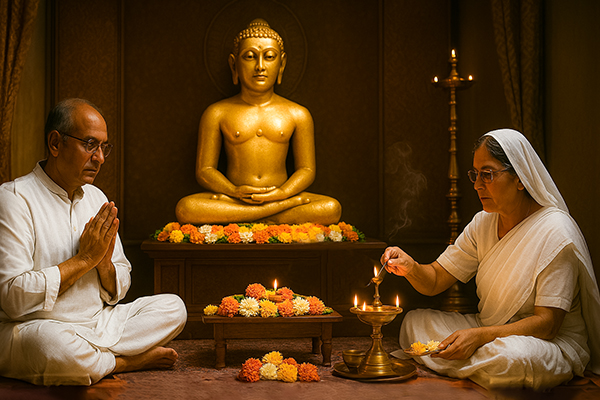
Many devotees observe vrata (fasting) on Mahavir Jayanti, either abstaining from food entirely or following a simple satvik diet. Some practice mauna vrat (silence) as a means of self-purification. Others engage in pratikraman (self-introspection rituals) to seek forgiveness and spiritual growth. Families come together to read from Jain scriptures like the Kalpa Sutra and Acharanga Sutra, ensuring that Mahavira’s teachings remain alive in future generations.
Jain Philosophy and Its Relevance Today
Jainism asserts that every soul has the potential for spiritual perfection if it follows the right path. The ultimate goal of Jainism is moksha (liberation), which can be achieved by removing karmic obstructions through right knowledge, right faith, and right conduct.
The universe is divided into two categories:
- Jiva (soul) – The sentient beings capable of attaining liberation.
- Ajiva (non-soul) – The material aspects of existence.
Jainism has significantly contributed to Indian philosophy, spirituality, and culture, advocating vegetarianism, non-violence, and ethical living. Mahavira’s teachings continue to inspire movements promoting peace, environmental conservation, and animal rights, making Jain philosophy relevant even in today’s world.
Mahavir Jayanti is not merely a religious observance but a spiritual awakening, reinforcing the principles of non-violence, truth, and ethical living. As we celebrate this festival, we are reminded that peace and enlightenment are achievable through self-discipline and compassion.
By following Mahavira’s teachings, one can walk the path of righteousness and liberation, ensuring a harmonious and spiritually enriched life.
How to celebrate Mahavir Jayanti

Temple Visits and Ritualistic Worship
On the sacred occasion of Mahavir Jayanti, devotees visit Jain temples early in the morning to participate in special pujas and abhisheka (ritualistic bathing of Mahavira’s idol). The temples are beautifully decorated with fresh flowers, toranas, and sacred Jain symbols. Devotees offer rice, milk, sandalwood, and seasonal fruits to the deity while reciting Jain prayers and mantras.
Many temples organize discourses and pravachans (spiritual lectures) on Mahavira’s life and teachings, emphasizing the core principles of Ahimsa (non-violence), Satya (truth), and Aparigraha (non-possessiveness). Jain monks and scholars narrate the inspiring journey of Bhagwan Mahavira, helping devotees gain deeper insights into his spiritual path.
Processions, Charity, and Acts of Compassion
A significant highlight of Mahavir Jayanti is the Shobha Yatra (grand procession), where devotees carry a beautifully adorned
idol of Bhagwan Mahavira
on a chariot. The streets echo with bhajans (devotional songs) and chants glorifying Mahavira’s divine wisdom. These processions take place in major Jain communities, drawing thousands of followers. The festival also underscores selfless service and charity, as Jains engage in anna daan (food distribution), donation drives, and medical camps to assist the underprivileged.
In accordance with Mahavira’s principle of non-violence, many people participate in animal welfare activities, bird feeding (Jiv Daya), and environmental conservation efforts, promoting harmony with all living beings.
Fasting, Meditation, and Reflection
Many devout Jains observe vrata (fasting) on Mahavir Jayanti, refraining from consuming food until sunset or following a simple satvik diet, devoid of root vegetables and processed foods. Some practice silence (mauna vrat) as a means of inner purification. Meditation and pratikraman (self-introspection rituals) are performed to seek forgiveness for past misdeeds and cultivate virtues like compassion and patience.
Families gather to discuss Mahavira’s teachings, read from Jain scriptures such as the Kalpa Sutra and Acharanga Sutra, and encourage children to imbibe values of kindness and ethical living. By engaging in these spiritual activities, devotees honor Bhagwan Mahavira’s legacy and reaffirm their commitment to a life of peace and righteousness.
Mahavir Jayanti Puja Vidhi (Puja Procedure)
.jpg)
Mahavir Jayanti is a highly auspicious festival for Jains, marking the birth anniversary of Bhagwan Mahavira, the 24th Tirthankara. On this day, devotees perform special pujas, abhisheka, and charitable activities to honor his teachings and seek spiritual progress. The puja is performed with purity, devotion, and mindfulness, adhering to Jain traditions.
Step-by-Step Puja Vidhi for Mahavir Jayanti
1. Purification and Preparation
- Wake up early before sunrise and take a holy bath to purify the body and mind.
- Wear clean, simple, and preferably white clothes, symbolizing purity and detachment.
- Clean the puja area and arrange all necessary puja samagri (materials).
- If possible, visit a Jain temple or create a sacred space at home for the puja.
2. Establishing the Idol or Picture of Bhagwan Mahavira
- Place a murti (idol) or image of Bhagwan Mahavira on a clean altar.
- Decorate the idol with fresh flowers and garlands.
- Keep a kalash (sacred water pot) and a diya (lamp) near the deity.
3. Abhisheka (Ritualistic Bathing of the Idol)
- Perform Jalabhisheka (ceremonial bathing) of the idol using pure water, milk, saffron water, and sandalwood paste.
- Some devotees also perform Panchamrit Abhisheka, using five sacred substances: milk, curd, honey, sugar, and ghee.
- After Abhisheka, wipe the idol with a clean cloth and apply sandalwood paste on its forehead.
4. Offering Rituals (Puja Samagri and Offerings)
- Light a diya (lamp) and incense sticks to purify the surroundings.
- Offer fresh flowers, akshata (unbroken rice), and fruits to Bhagwan Mahavira.
- Place naivedya (sattvic food), preferably simple fruits and sweets, in front of the deity.
- Some devotees also offer tulsi leaves and sacred grains as a mark of reverence.
5. Chanting and Recitation of Jain Mantras
Recite Jain stotras and Mahavir Jayanti prayers.
Chant the
Namokar Mantra
, which is the most sacred mantra in Jainism:
This mantra pays homage to the Arihants, Siddhas, Acharyas, Upadhyayas, and all Jain monks.
Recite Shri Mahavir Swami Ashtak Stotra and verses from the Jain Agamas.
If performed in a temple, participate in pravachans (discourses) by Jain monks.
6. Performing Aarti and Prayers
- Light a camphor flame and perform aarti of Bhagwan Mahavira, moving the lamp in a circular motion.
- Sing Jain bhajans or stutis praising Bhagwan Mahavira’s virtues.
- Conclude with a silent prayer seeking wisdom, non-violence, and truthfulness in life.
7. Observing Fasting and Charity (Daan-Dharma)
- Many devotees observe fasting (vrata) on Mahavir Jayanti. Some practice Ekashana (one meal a day) or Upavasa (complete fasting).
- Engage in selfless service and charity by distributing food, clothes, and essentials to the needy.
- Perform Jiv Daya (compassion towards animals) by feeding birds, saving stray animals, and avoiding harm to any living being.
8. Reflection and Meditation
- Meditate on Bhagwan Mahavira’s teachings, contemplating the principles of Ahimsa (non-violence), Satya (truth), and Aparigraha (non-possessiveness).
- Practice Pratikraman (self-introspection), seeking forgiveness for past misdeeds.
- Read from Jain scriptures such as Acharanga Sutra, Kalpa Sutra, and Uttaradhyayana Sutra to deepen spiritual understanding.
By following the puja vidhi with sincerity, one can honor Bhagwan Mahavira’s life and teachings, reinforcing the values of peace, compassion, and righteousness. Through prayers, fasting, meditation, and acts of charity, devotees strengthen their commitment to the path of Jain Dharma, striving for inner liberation and universal harmony.
Mahavir Jayanti Puja Mantra
Namokar Mantra (Navkar Mantra)
This is the most sacred and fundamental mantra in Jainism. It is chanted at the beginning of all pujas, prayers, and rituals, as it venerates the five supreme beings of Jain Dharma.
Mantra:
ॐ णमो अरिहंताणं।
ॐ णमो सिद्धाणं।
ॐ णमो आयरियाणं।
ॐ णमो उवज्झायाणं।
ॐ णमो लोए सव्वसाहूणं।
Meaning:
Namo Arihantanam
– I bow to the Arihants (Enlightened Ones).
Namo Siddhanam
– I bow to the Siddhas (Liberated Souls).
Namo Ayariyanam
– I bow to the Acharyas (Spiritual Teachers).
Namo Uvajjhayanam
– I bow to the Upadhyayas (Preceptors).
Namo Loe Savva Sahunam
– I bow to all monks and sages in the world.
Benefits of Chanting Namokar Mantra:
- Purifies the soul and mind.
- Removes negative karma and brings spiritual enlightenment.
- Helps in self-discipline and attaining inner peace.
Mahavir Jayanti Vrat Vidhi (Fasting Procedure)
.jpg)
Fasting on Mahavir Jayanti is a sacred practice observed by Jain devotees to purify the body, mind, and soul while honoring the teachings of Bhagwan Mahavira.
The vrata (fasting) is performed with devotion, focusing on self-discipline, meditation, and non-violence. Devotees begin their day early with a holy bath and wear clean, white clothing, symbolizing purity and detachment from material desires. The fast is undertaken with the intent of spiritual upliftment rather than mere abstinence from food. Some devotees opt for Upavasa (complete fasting without food and water), while others follow Ekashana (one meal a day) or Beasana (two meals a day), ensuring that the food consumed is sattvik and non-violent in nature, avoiding root vegetables and processed ingredients.
During the fast, devotees spend time in prayers, pujas, and scriptural readings, reflecting on the teachings of Bhagwan Mahavira. Temples conduct special discourses and pravachans (spiritual sermons) where Jain monks emphasize Ahimsa (non-violence), Satya (truth), and Aparigraha (non-possessiveness) as the core principles of Jainism. Many also engage in Pratikraman (self-introspection and repentance), seeking forgiveness for past misdeeds and resolving to lead a righteous life.
Meditation and chanting of the Navkar Mantra help devotees attain mental clarity and inner peace. Acts of charity and kindness are also encouraged, including feeding the needy, saving animals, and donating for welfare causes, reflecting the compassionate philosophy of Jainism.
The fast is broken after sunset or the next day, depending on the devotee’s spiritual commitment. Those observing strict fasting may conclude it with boiled water or light sattvik food, ensuring that they maintain self-restraint and gratitude. The vrat is not only a physical discipline but also a spiritual journey towards self-purification and liberation.
By following this vrat vidhi, devotees seek Mahavira’s divine blessings, aspiring to lead a life of simplicity, kindness, and non-violence, thereby walking the path of moksha (liberation) that he preached.
Mahavir Jayanti Vrat Katha (Traditional Fasting Story)
.jpg)
In ancient times, there lived a wealthy and righteous merchant named Dharmaruchi in the kingdom of Vaishali. He was known for his devotion, charity, and adherence to Jain principles. Despite his wealth, he remained humble and sought spiritual enlightenment. One year, on Mahavir Jayanti, he decided to observe a strict fast (vrata) to honor Bhagwan Mahavira. He vowed to abstain from all food and water, dedicating his day to prayers, meditation, and self-purification.
As Dharmaruchi immersed himself in devotion, he was visited by a wandering sage who told him the story of a poor but devoted Jain woman named Satyavati. Despite her hardships, she observed Mahavir Jayanti Vrat every year with deep faith. One such year, she had no food to offer as an end-of-fast meal, yet she continued her vrata with unwavering determination. Impressed by her devotion, Bhagwan Mahavira appeared in her dream, blessing her with spiritual wisdom and prosperity. The very next day, her circumstances miraculously changed, and she received abundant food, wealth, and inner peace.
Hearing this story, Dharmaruchi was filled with even greater devotion and gratitude. He continued his fasting with renewed faith, spending the day in chanting the Navkar Mantra, engaging in charity, and listening to Jain scriptures. At sunset, as he concluded his fast, he felt a divine presence and immense spiritual bliss, realizing that true wealth lies in detachment, righteousness, and self-discipline.
Since then, it is believed that those who observe Mahavir Jayanti Vrat with sincerity, focusing on non-violence, truth, and charity, receive Bhagwan Mahavira’s blessings and progress toward moksha (liberation). This sacred katha continues to inspire Jain devotees to observe the vrata with unwavering faith, leading a life of virtue and compassion.
Puja Utensils, Essentials
Rudra Centre
brings an extensive collection of Puja Articles which caters to all that is required for daily and special Puja Vidhis. We offer variants of designs and sizes in each category. The list includes handcrafted Puja Mandirs, Puja Pedestals, offering Bowls, Panchpatra, intricately carved Puja Thalis, Abhishek Vessels, in different materials, Pure Silver/German Silver articles like Kalash, set of Shodash Upachara and Several other Puja Articles, which we deliver at your doorstep.
Visit the complete collection:
Conclusion
Mahavir Jayanti is a profound celebration of spiritual awakening, self-discipline, and the timeless pursuit of liberation. This sacred occasion venerates the life and wisdom of Bhagwan Mahavira, illuminating the path of non-violence, truth, compassion, and renunciation of material attachments. Through fasting, prayer, and acts of generosity, devotees immerse themselves in the eternal virtues of purity, righteousness, and inner clarity, seeking divine blessings for tranquility and progress on the path of dharma. As sacred mantras resonate and the essence of Bhagwan Mahavira’s teachings fills the air, this auspicious day becomes a moment of deep devotion, reaffirming that true liberation is attained through unwavering faith, mastery over desires, and the pursuit of the highest truths.


-in-Astrology.jpg)
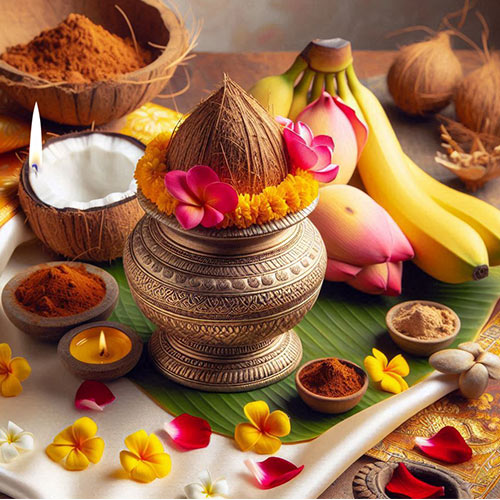
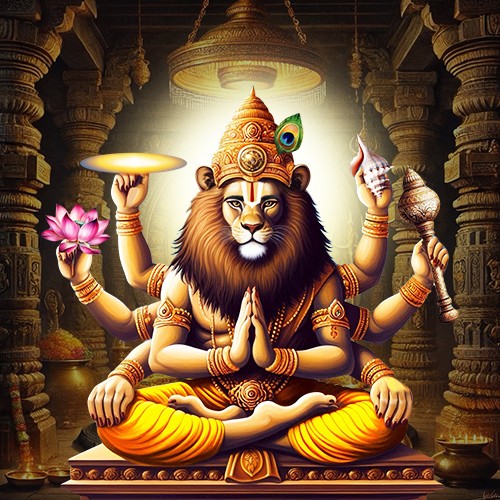
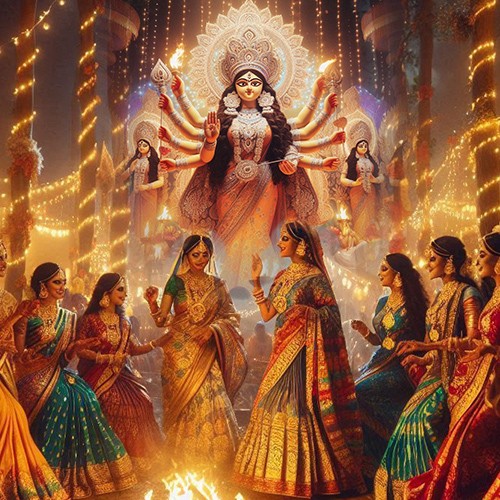
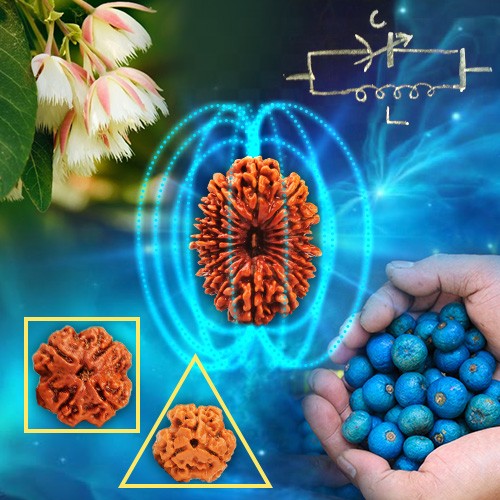

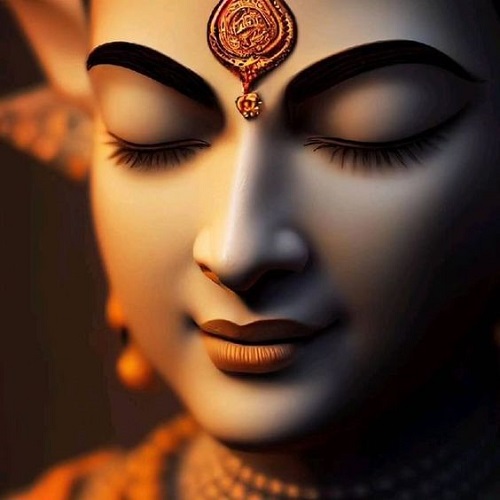
.jpg)
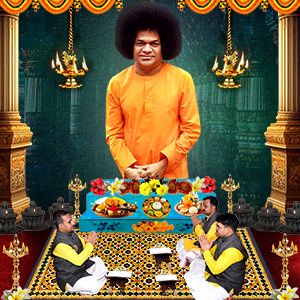
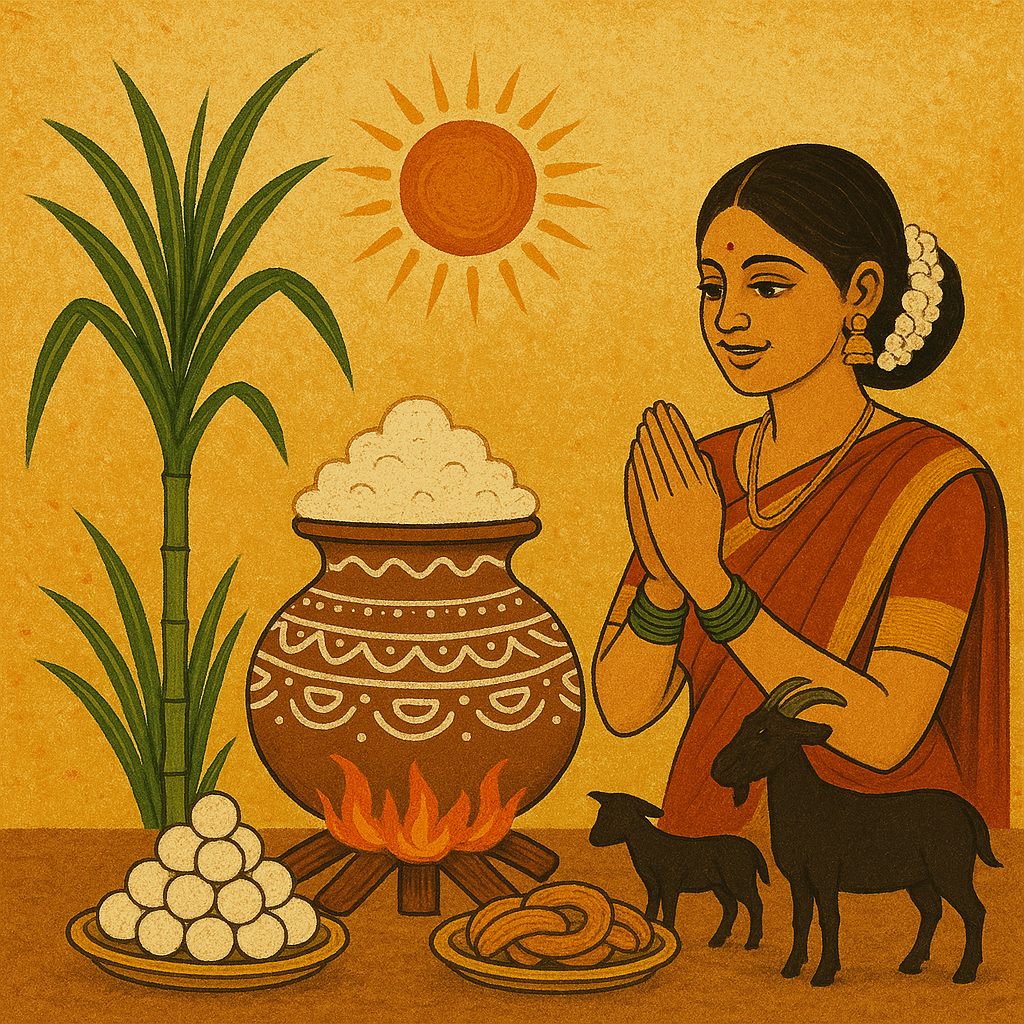
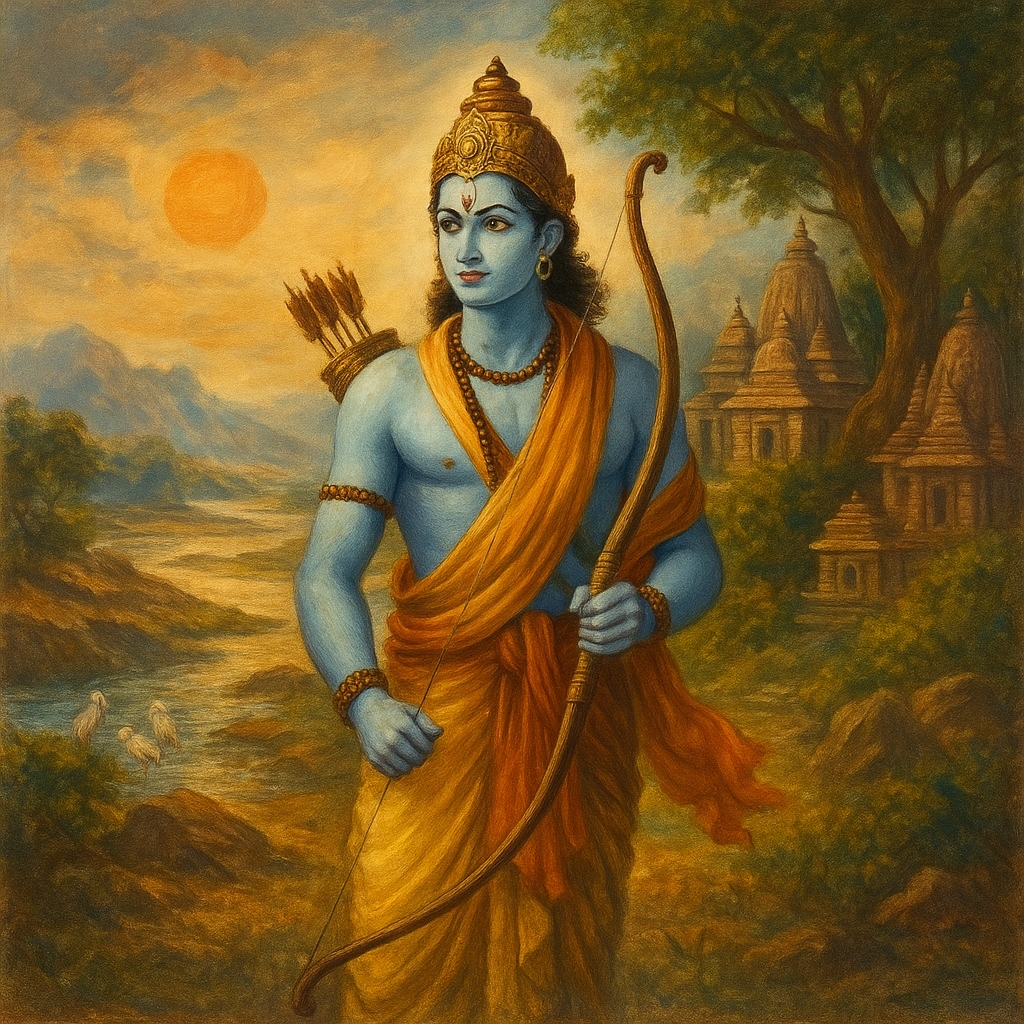
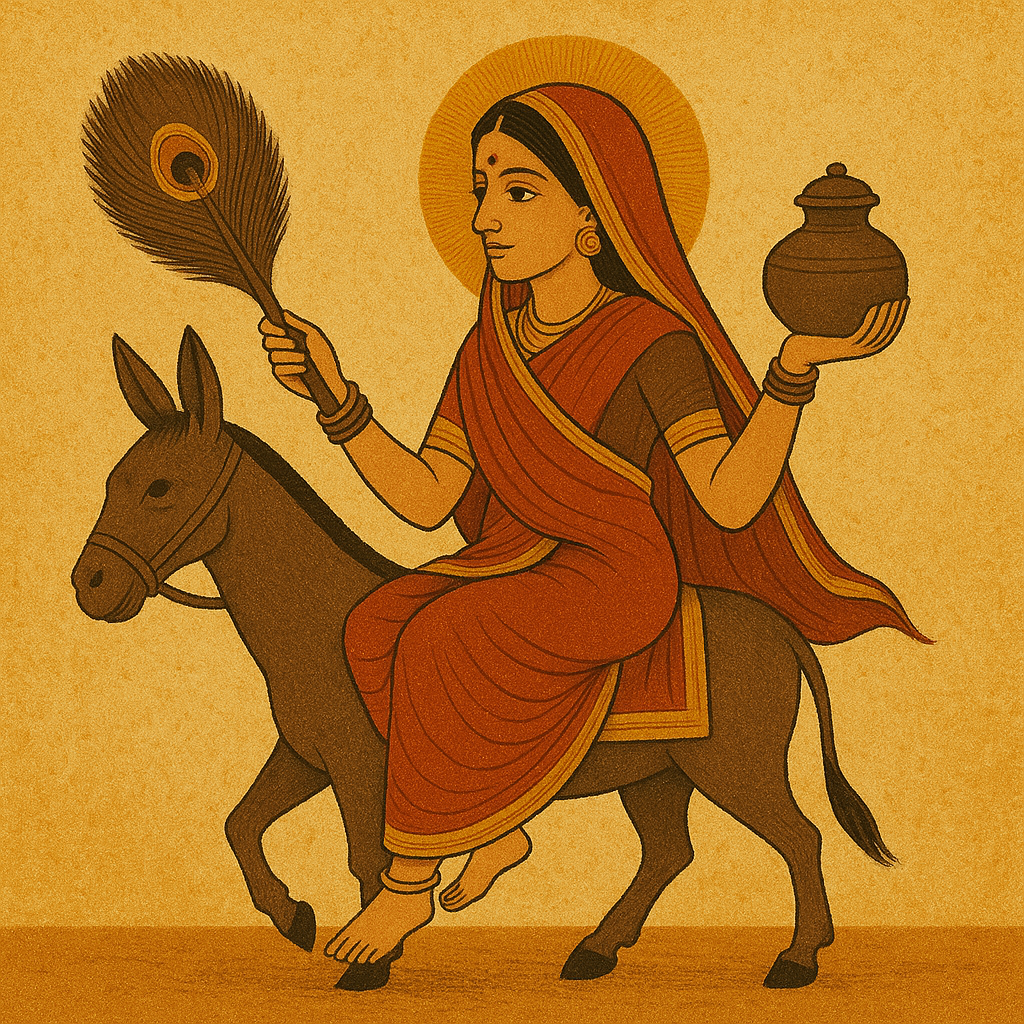
Comments 0
Leave your thought here